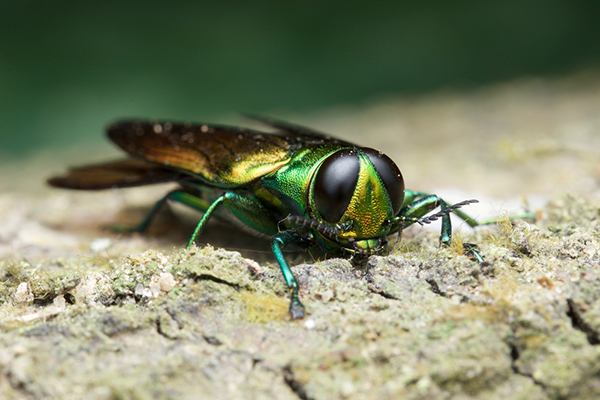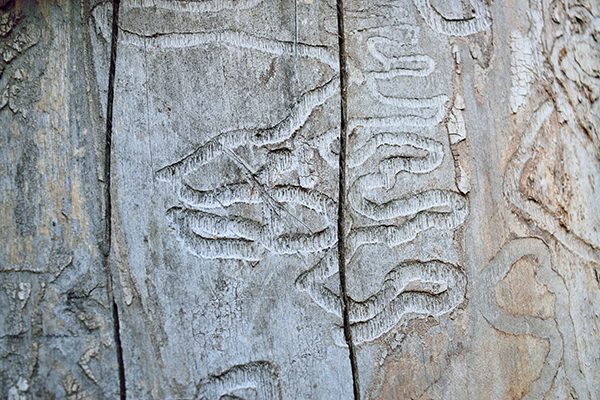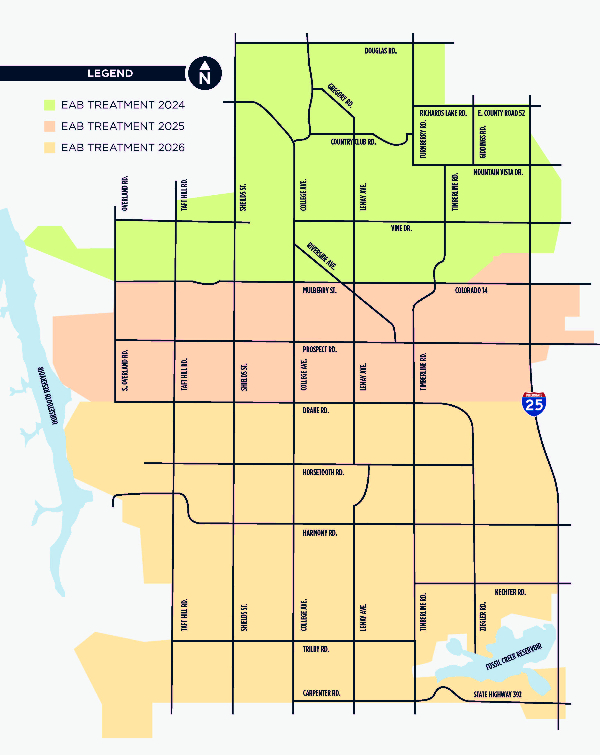Emerald Ash Borer#

Emerald Ash Borer
EAB is a highly destructive, non-native insect that infests and kills all North American true ash species. Infested trees gradually die over a period of approximately two to four years.
Emerald Ash Borer (EAB) was detected several years ago north of Fort Collins, and is now within city limits.
To mitigate the impacts of EAB, the City of Fort Collins has developed an Emerald Ash Borer Response Plan. The plan outlines a phased treatment approach for all strategically selected, City-owned ash trees.
There are approximately 70,000 ash trees in Fort Collins, which equals 33% of the canopy cover. The City maintains about 10% of the 70,000 ash trees, the remaining are privately-owned, making it important for community-members to make their own ash management plan.
All city-owned trees and species are tracked in TreeKeeper. This is a useful tool when identifying whether the trees near you fall under the city management plan or should be handled privately.
If you’d like to help Forestry Plan(t) for the Future and diversify our Urban Forest, visit fcgov.com/citygive
City Treatment Phases#
The Forestry Division has strategically selected 2,100 City-owned ash trees to be treated in a three-year rotation. To learn more about the City selection process, view appendix A in the Emerald Ash Borer Response Plan.
Anyone interested in self-funding treatment of trees in the public-right-of-way that are not being treated by the City Forestry Division, should contact forestry@fcgov.com to receive a permit, prior to starting independent treatments. Permits will be issued only after a tree evaluation to assess if it is worth treating. To see which City-owned trees are being treated, click on the tree in TreeKeeper.
Evaluation criteria for self-funded ash treatment:
- Size: Tree is 8 inches in diameter or greater (diameter measured at 4.5’ above ground)
- Tree Condition: Tree is in fair to good condition
- Canopy: Tree has a healthy and full canopy
- Structure: The tree has good overall structure
- Health: Is the tree diseased? Is there evidence of insect damage? Are there trunk wounds present?
Making an Ash Management Plan#

Tree damage from EAB
Tips on identifying ash trees are available through Colorado State University.
EAB signs and symptoms include thinning canopy, loss of leaves, new sprouts on lower trunk or lower branches, vertical splits in bark, D-shaped exit holes about 1/8-inch wide, S-shaped tunnels produced by larvae under the bark, and increased woodpecker activity.
If you determine you have an ash tree in your yard, please call a City of Fort Collins licensed arborist to evaluate your tree.
Consider the benefits that your ash tree(s) provide to your property.
- Do they shade your house?
- Are they large, healthy trees?
- Do the benefits of treating the ash tree long term outweigh the costs?
- Or, should the ash tree be removed and replaced?
Next, develop a plan for removal and replacement or treatment of your ash tree(s) by working with a local licensed arborist.
If you decide to treat your ash tree(s) with an insecticide, keep up with the treatments as EAB has never been eradicated out of a community. Water, water, water! This will keep your tree healthy and help with better pesticide uptake once you start treating.
If you decide to not treat your ash tree(s), it is safer to remove the tree before it is killed by EAB. Make sure that you are replacing them with a suitable species for this area. If you are planting multiple trees, make sure that you diversify so that when the next pest moves in, you are then prepared.
Slow the Spread#
EAB has never been eradicated out of a community so the best thing to do now is slow the spread in Fort Collins and prevent the spread to other communities.
- The number one cause of the arrival of EAB in a community is humans. Do not move firewood!
- Keep all ash material local in order to prevent the spread of EAB to other communities.
- If you’d like to help Forestry Plan(t) for the Future and diversify our Urban Forest, visit fcgov.com/citygive/
Frequently Asked Questions#
-
Yes. EAB has been detected in Fort Collins and is slowly spreading.
-
Adult beetles are strong flyers, but they typically fly less than half a mile once they emerge from their host tree. This means that the pest most likely arrived in our area via human transport of infested ash wood, such as firewood or other raw ash material.
-
EAB has never been eradicated from an area or community since its detection within the United States in 2002.
Leading entomologists suggest that EAB has the potential to bring about the extinction of North American ash species if the pest is not managed.
-
- Become educated and stay vigilant
- Report suspect ash trees or beetles to the Forestry Division
- Remove and replace low-value ash trees with a diverse palette of tree species that are capable of becoming large shade trees at maturity.
- Never move firewood, ash nursery stock, or raw ash material:
- From one community to the next
- From one spot within our community to another, except when moving to a proper disposal site
-
An adult EAB is an emerald green metallic beetle that is about ½-inch long and is bullet-shaped. The area under the wing covers of an adult beetle is coppery red. The larva is off-white and flat with bell-shaped segments and can grow up to be about 1-inch long.
-
EAB larvae damage trees by tunneling under the bark, producing girdling wounds that interfere with the movement of water and nutrients. Infested trees gradually die over a period of 2 to 4 years.
-
All true ash trees (Fraxinus spp.) have the following characteristics:
- Leaves are compound, which means multiple leaflets occur on a common stalk, and typically have five to nine leaflets. The one exception is single-leaf ash which may have simple or compound leaves, with up to five leaflets.
- Leaflets are smooth or finely toothed along the edges.
- Seeds on female trees are paddle-shaped.
- Branches and buds grow in pairs, directly opposite from each other.
- Mature bark displays diamond-shaped ridges.
The following App is a handy tool to help you identify what type of trees you may have on your property: search for EAB/Ash Tree ID. Not an App/smartphone user? Send pictures to forestry@fcgov.com or contact a Licensed Certified Arborist.
Wondering if the trees on your street are Ash trees? Find out here.
-
The presence of EAB in a tree typically goes undetected until more than a year after initial infestation. Symptoms of infested trees may include:
- Thinning of upper branches and twigs
- Loss of leaves
- S-shaped tunnels produced by larvae under the bark
- D-shaped exit holes about 1/8-inch wide
- New sprouts on the lower trunk or lower branches
- Vertical splits in the bark
- Increased woodpecker activity
-
There are many EAB look-alikes. However, if you believe that you have found EAB, please contact Forestry at 970-221-6660 or email forestry@fcgov.com.
-
Forestry has been preparing for EAB since it was first detected in the United States starting in 2003. We’ve worked hard to make sure that ash trees were not planted along City streets or in new City parks. Since then, Forestry has received some extra funding to remove and replace ash trees in poor condition or shadow plant ash trees as space allows.
Over the last few budget cycles, we have been able to reduce our public ash tree population from 16% to 14%.
Forestry also keeps an inventory of our entire ash tree population. This inventory includes updated tree diameters, conditions and helped establish prioritization of EAB treatment plans going forward.
-
We suggest hiring a licensed, certified Arborist for all pruning, removal, and pesticide treatment work. Click here for a current list of certified Arborists in your area. You can also contact us for more information at 970.221.6660 or forestry@fcgov.com.
-
At this time, the Forestry Division is advising Fort Collins residents to act now and start implementing their own EAB management plans. Residents should first determine if their property has any ash trees, and if so, evaluate the condition of each tree, with continued monitoring throughout the year. Residents should also decide whether to have infected ash trees treated, or removed and replaced. City Forestry staff urge residents to weigh the benefits and costs associated with ash removal and replacement, versus ongoing insecticide treatments.
-
If the ash tree is in poor health or is smaller than 11-inches in diameter, Forestry recommends either planting another tree near-by (shadow planting) or removing and replacing the ash with a suitable species for the Front Range.
-
You can have the tree removed, but we strongly suggest that you replant it with a new tree species that is well adapted to our area. Be aware that EAB is an aggressive pest and has never been eradicated from any community, so if you chose not to treat, your tree will eventually be killed.
-
Although there are pesticides available “over the counter” for homeowners to treat their tree(s), we highly recommend that you consider hiring a certified Pesticide Applicator. Even better, take it one step further and hire a licensed Tree Care Company that operates a Plant Health Care Division. If you decide to treat the tree yourself, make sure that you read the pesticide label and understand the risks associated with applying pesticides. The label is actually the law for using that pesticide legally, so follow all instructions closely.
-
If your ash tree(s) are properly treated, the pesticide will prevent the ash tree from being killed by EAB. Make sure that you understand the frequency of your pesticide treatment. Some pesticides may only control EAB for one year and others for up to two years. It is important to understand that pesticide applications will need to be carried out for the duration of your tree’s life; once stopped your tree(s) will be susceptible.
-
Emerald ash borer is here, however, it is not too late to develop a management plan for your Home Owners’ Association (HOA). City Forestry staff are available to go over options and guidelines with your HOA. We can do this over the phone, through email, or even by setting up a live or virtual meeting with your management company, the board or the entire HOA. Please reach out to your HOA board to determine the best way to proceed. It will help City Forestry staff greatly if there are only one or two primary contacts assigned for each HOA. Please call 970.221.6660 or email us at forestry@fcgov.com for more information.
-
Diversity is key to a healthy urban forest. Please consider replacing the ash tree with a large maturing shade tree. Click here for suggestions.
-
“Shadow planting” is a great option for planning or planting for the future! Plant a tree near an ash tree that you do not intend to treat. This will ensure that a new tree is well established and growing when it comes time to remove your ash tree.
